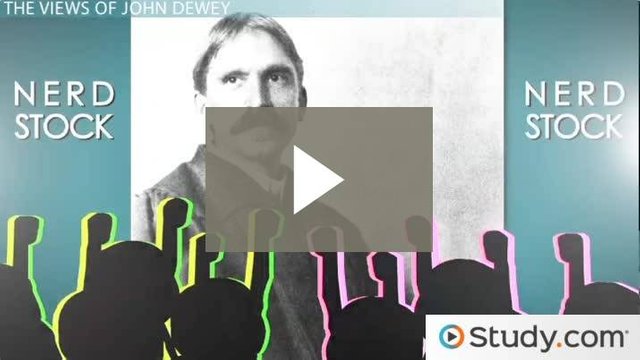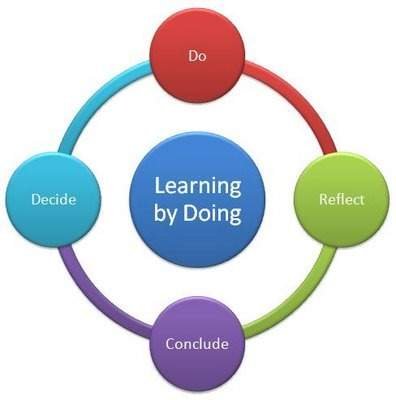How John Dewey's Learning Model Becomes A Solution For students To Acquire Knowledge
Democracy and Education By John Dewey Learning by doing
some people who work as teachers interpret "educating" and "teaching" is same so that a teacher can get caught up in this misconception. Yet between "educating" and "teaching" there is a fundamental difference.
Given styles of learning between one student and other student is different so that many educator figures discuss theories of learning, such as Jean Piaget's learning theories, the Gestalt learning theories, and others.
One of the educational figures of America who offers a pattern of participatory education is John Dewey. According to him, participative education will bring learners to be able to deal directly with environmental reality. Thus, learners can integrate the material that he learned in the classroom with the reality.
John Dewey on Education: Impact & Theory
John Dewey is an educational reformer and a social critic who greatly influenced US society in the early and mid-20th centuries. Together with Charles Sanders Peirce and William James, he became the chief spokesperson of American philosophy, Pragmatism, and he is the leader of the progressive education movement.
John Dewey was born October 20, 1859 in Burlington, Vermont. He is the third child of the four brothers of the couple Artchibald Dewey and Lucina Rich. After completing his preparatory education at Burlington's state school, he entered the University of Vermont in 1875, but only in the fourth year he discovered his special intellectual interest.
In 1882, he attended a postgraduate program at John Hopkins University which was then founded.
Dewey started his major in the theory and practice of education at the University of Chicago, as he served as head of the philosophy, psychology, and pedagogy department in 1894. While in Chicago, Dewey became famous in education. In 1904, due to his opposition to the rector of the education department's finance and management, Dewey left Chicago and became professor of philosophy at the University of Culumbia, New York. And then at June 1, 1952, Dewey died of pneumonia.
How Dewey's Model For Teaching Students
In many books and articles written by John Dewey has given rise to progressive education theory. Dewey's thinking about education is in line with his instrumental conception, where the basic concepts of experience, growth, experiment, and transaction have close intimacy, so Dewey describes philosophy as a general theory of education. Education and philosophy need each other; where without philosophy, education will dry the intelegency.
John Dewey in his book Democracy and Education, argues that the primary facts of the death and birth of each member of the constituent in the social group determine the importance of education.[Wikipedia]
For Dewey, education and learning are social and interactive processes. Thus the school itself can be said to be a social institution through which social reform can and should be done.
In addition, Dewey believes that students develop in an environment where they are allowed to experience and interact with the curriculum, and all students should have the opportunity to take part in their own learning.
John Dewey's thoughts on education focus more on "progressive education" education. Basically, progressive education is education that emphasizes the need to learning by doing.[Wikipedia]
Pragmatists education means students have to interact with their environment in order to adapt and learn. According to Dewey that the teachers and students should learn together. His view of the class is deeply rooted in the ideals of democracy, which promotes the same voice among all participants in the learning experience.
Thereby learning the John Dewey model, indicating that the teacher should present a real problem to the student, then direct and guiding the students to solve the problem by giving them (students) direct activities to learn the solution.
This is in line with John Dewey's pedagogical recognition, he said: “I believe that the school must represent present life – life as real and vital to the child as that which he carries on in the home, in the neighborhood, or on the playground.”[Pedagogic Creed by John Dewey ]
For example:
Learning to throw a ball, drive a car, design a building, cook stir-fry, or become a management consultant and so forth.
Parents usually teach children in this way. They do not give a series of lectures to their children to prepare them for walking, talking, climbing, running, playing games, or learning to behave. They let their children do these things.
Another example, giving the boy a ball to teach him to throw. If he throws him down badly, he will just try again. Another example, Parents tolerate sitting in the passenger seat while their teen trying the driver's seat for the first time. It's very stressful, but parents tolerate it, because they know there's no better way.
However, instead of letting students learn by doing, but teachers create a teaching course that tells students about task theory without concentrating on the execution of tasks.
Conclusion
Thus clearly the learning John Dewey's model teaches us how important the meaning of work because it works to provide experience and experience leading people to think so as to act wisely and correctly.
Thus, this learning model can become is a better alternative to teaching people of all ages new things by all of which are based on learning by the approach.
References:

